It looks like you're using an Ad Blocker.
Please white-list or disable AboveTopSecret.com in your ad-blocking tool.
Thank you.
Some features of ATS will be disabled while you continue to use an ad-blocker.
share:
a reply to: wildespace
I find this piece of rock highly interesting. The irregular shape and many craters. It's orbit is apparently very unpredictable. At least that's what wiki says.
It puzzles me...how can an orbit be unpredictable ? Is it not stable ?
I find this piece of rock highly interesting. The irregular shape and many craters. It's orbit is apparently very unpredictable. At least that's what wiki says.
It puzzles me...how can an orbit be unpredictable ? Is it not stable ?
a reply to: wildespace
yes..I've red the explanation....but I wonder...since it's low gravity and small size...should it really attract that much meteorites ? I'm kinda thinking...it looks like it got "showered" properly.
I think it's due to its very low density. On the much denser moons, craters are kind of smoothed out by gravity and by the density of the material that gets disturbed. It's like trying to make craters in dough or clay. On Hyperion, on the other hand, each impact produced a neat depression that stayed preserved in its original state, as there's not enough gravity or "fluidity" of the material to smooth it over.
yes..I've red the explanation....but I wonder...since it's low gravity and small size...should it really attract that much meteorites ? I'm kinda thinking...it looks like it got "showered" properly.
originally posted by: MarioOnTheFly
a reply to: wildespace
I find this piece of rock highly interesting. The irregular shape and many craters. It's orbit is apparently very unpredictable. At least that's what wiki says.
It puzzles me...how can an orbit be unpredictable ? Is it not stable ?
I think you confused orbit with rotation. Hyperion's rotation is chaotic, it's basically tumbling. One guess, which also explains its irregular shape, is that this moon is the result of a big impact between bodies in the early Solar System.
since it's low gravity and small size...should it really attract that much meteorites
Impacts don't necesseraly happen because of gravitational attraction. When there's lots of stuff flying around, as it was in the early Solar System, lots of stuff is bound to cross your path at some point or the other.
~~~
On the topic of true-colour images, I have since found out that Hyperion is actually quite dark and reddish in appearance. It comes out neutral-grey in my pictures because I was using uncalibrated, raw images. The Planetary Data System, or PDS, has the calibrated versions, which allow us to create the "really" true-colour images. So I went and made one:
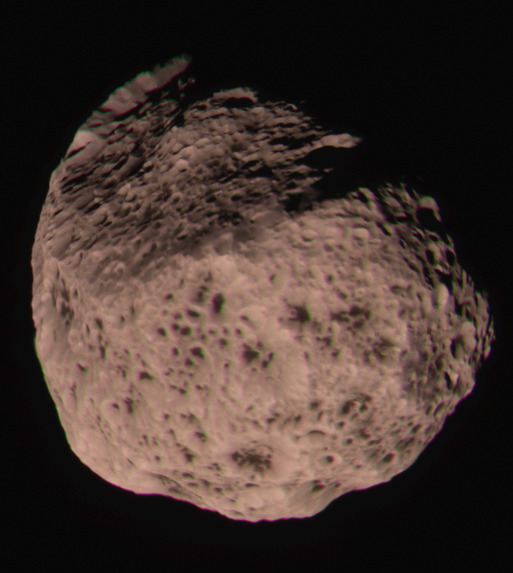
Hyperion's surface actually closely matches the colour of dark material on Iapetus' surface.
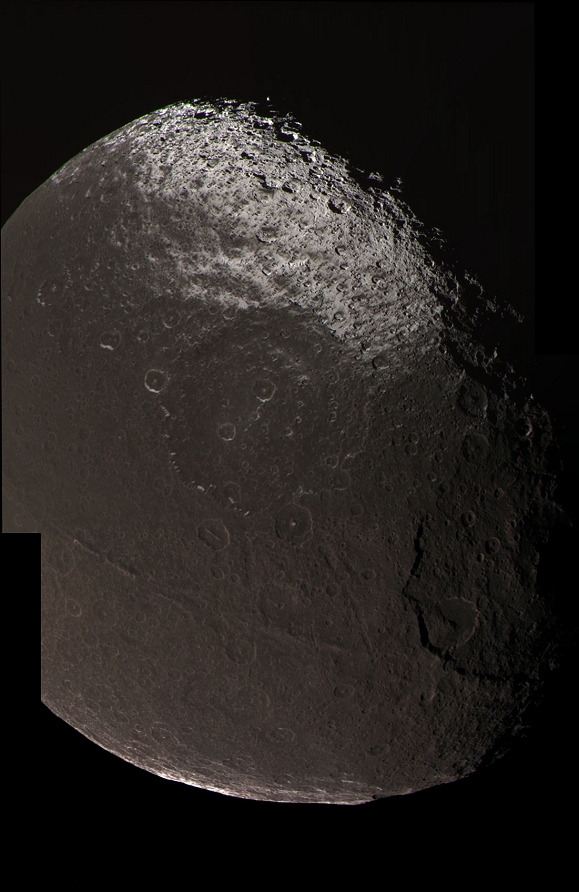
edit on 2-6-2015 by wildespace because: (no reason given)
a reply to: wildespace
indeed. I re red the wiki page...and it only states "chaotic" rotation.
I thinking...gigantic pool table...tiny marble sized balls...Hyperion is only 800 something kilometers on equatorial circumference. That's somewhat tiny. In statistical probabilities...the tinier it is...the less craters there should be...or am I wrong ?
I think you confused orbit with rotation.
indeed. I re red the wiki page...and it only states "chaotic" rotation.
When there's lots of stuff flying around, as it was in the early Solar System, lots of stuff is bound to cross your path at some point or the other.
I thinking...gigantic pool table...tiny marble sized balls...Hyperion is only 800 something kilometers on equatorial circumference. That's somewhat tiny. In statistical probabilities...the tinier it is...the less craters there should be...or am I wrong ?
a reply to: wildespace
Based on what we know of some of the solar system's moons, and the continuing missions providing further information, I think it's safe to say, man has not yet set foot on "The" moon.
"Earth's moon", or "a moon", yes, but while important to us here on Earth, it's otherwise far from being " "The" moon
Based on what we know of some of the solar system's moons, and the continuing missions providing further information, I think it's safe to say, man has not yet set foot on "The" moon.
"Earth's moon", or "a moon", yes, but while important to us here on Earth, it's otherwise far from being " "The" moon
a reply to: dogstar23
we really don't know, no one except our astronauts admits to ever setting foot on our Moon there must be a good reason for the secrecy, could be 'our' moon is the 'best' moon all told, again it is top secret and no one admits what moons and planets purpose is, some might not be as nice as ours
we really don't know, no one except our astronauts admits to ever setting foot on our Moon there must be a good reason for the secrecy, could be 'our' moon is the 'best' moon all told, again it is top secret and no one admits what moons and planets purpose is, some might not be as nice as ours
originally posted by: MarioOnTheFly
I thinking...gigantic pool table...tiny marble sized balls...Hyperion is only 800 something kilometers on equatorial circumference. That's somewhat tiny. In statistical probabilities...the tinier it is...the less craters there should be...or am I wrong ?
Well, for one thing, Hyperion is small, but not tiny. If it was an asteroid, it would be among the top-10 largest. Also keep in mind that ALL celestial objects much larger than a speck of dust accreted from collisions with other dust specks and larger things over the eons, so unless there is something to erase the craters (such as an atmosphere or surface melting), all will bear signs of impacts.
That said, small objects (such as Eros ) can be blown apart by high-speed impacts, so if they exist at all, they do (as you say) show fewer large craters. Asteroid Itokawa, which is only a few hundred meters across shows hardly any.
edit on 3-6-2015 by Saint Exupery because: (no reason given)
originally posted by: blacktie
a reply to: dogstar23
we really don't know, no one except our astronauts admits to ever setting foot on our Moon there must be a good reason for the secrecy, could be 'our' moon is the 'best' moon all told, again it is top secret and no one admits what moons and planets purpose is, some might not be as nice as ours
What secrecy? And what purpose? What are you on about mate?
originally posted by: 0bserver1
Those are great pictures. I always wonder why the stars aren't visible on NASA pictures, let's say they do it to bring the objects in clearer view.
It's almost if hyperion is an old trapped comet around Saturn .. you can see the ice very clearly, nice comparison to the Ceres ice mystery.
It also amazes me that the rings of Saturn who are only thirty feet thick show so much density,what would happen if a satellite flies through these rings with a amount of speed collecting material and how long will it take for Saturn to repair these rings? what a sight seeing it would be if you could be there one day..
Thanks for posting.
From what I understand, you can't see stars unless you are looking through an atmosphere. The sun you could see from earth orbit, but it would be a little white ball, not a huge glowing object. Stars are electromagnetic spheres, planets atmospheres are what let us see them. Although that is not a fact by any means, it's the way I'm leaning, the more I study
originally posted by: LuckyYurg
From what I understand, you can't see stars unless you are looking through an atmosphere. The sun you could see from earth orbit, but it would be a little white ball, not a huge glowing object. Stars are electromagnetic spheres, planets atmospheres are what let us see them. Although that is not a fact by any means, it's the way I'm leaning, the more I study
I really don't want to sound like a jerk, but there's no gentle way to say this:
Almost everything you wrote in that post is wrong.
...you can't see stars unless you are looking through an atmosphere.
Incorrect. It's more difficult to see stars through an atmosphere due to absorption & scattering of light. Without the atmosphere, stars (including the Sun, Moon, planets and everything else) would appear ~20% to 40% brighter than we see them on Earth (this can be confirmed by a simple experiment without any special equipment) and will not twinkle due to atmospheric instability. This is why the Hubble Space Telescope images are so clear.
The sun you could see from earth orbit, but it would be a little white ball, not a huge glowing object.
We don't see the Sun as a huge glowing object. We see it as and extremely bright glowing object, and if we were in space it would appear ~20% - 40% brighter than it does on Earth. However, whether you are standing on the Earth, or on the Moon or in orbit somewhere in between, the Sun (which is, in fact, white) will appear the same angular size: ~1/2 of one degree. By a rather cool coincidence, this is about the same angular size that the Moon appears from Earth and this moment in history. The Moon used to be closer and appear larger. It's slowly moving away, so it will someday appear smaller than the Sun.
Stars are electromagnetic spheres
The Sun is a large ball of material 333,000 times more massive than the Earth. We know its mass because we can measure its gravitational influence on everything from planets' orbits to tides in the Earth's oceans.
Thanks to spectroscopy, we know that most of the material is hydrogen & helium, with small proportions of oxygen, carbon, neon, nitrogen, iron and other elements.
We know through totally non-controversial physics what happens when you have a ball of material like that it space: Gravity causes it to collapse in on itself and compress. We know from experiment that when gasses compress (that is, pressing a constant mass into a smaller volume, thus increasing density), they heat up (google Boyle's law), and we can calculate the temperature and pressure when that much matter collapses on itself.
In the last century, we learned that when the temperature and density are high enough (as high as they are at the Sun's core), atoms can be crushed into each other - forming heavier elements and releasing titanic amounts of energy. This is not theoretical: we have reproduce this phenomenon here on Earth many times. Link
planets atmospheres are what let us see them.
If that were true, how could we see things that aren't stars? With your own eyes you can see the phases of the Moon (and with binoculars, Venus) so you ought to know that light is reflecting off of them, and if it can do that, then there is no reason that the light cannot be detected wherever it falls either on Earth or in space.
The reason stars don't show up in photos of things like Saturn's moons is that when you set a camera to correctly photograph a sunlit scene, stars will be too faint to see. Conversely, you can set a camera to record the stars, but if you use those settings to record a sunlit scene, that part of the image will be grossly over-exposed. Again, this is a simple experiment you can try for yourself.
Although that is not a fact by any means, it's the way I'm leaning, the more I study
This is the most accurate thing you wrote. I'm glad you're still studying, but make sure you're using credible (and not just credulous) sources. Here on ATS, some people seem to think that if it's "mainstream" it can't be true, and that unsupported speculations farted-out by charlatans - who have never taken the time or effort to understand the world around them - somehow carry the same weight as decades or centuries of research, experiments & observations by people who are as diligent as they are imaginative.
Here's a fantastic and very detailed image of Hyperion in approximately true colours:
upload.wikimedia.org...
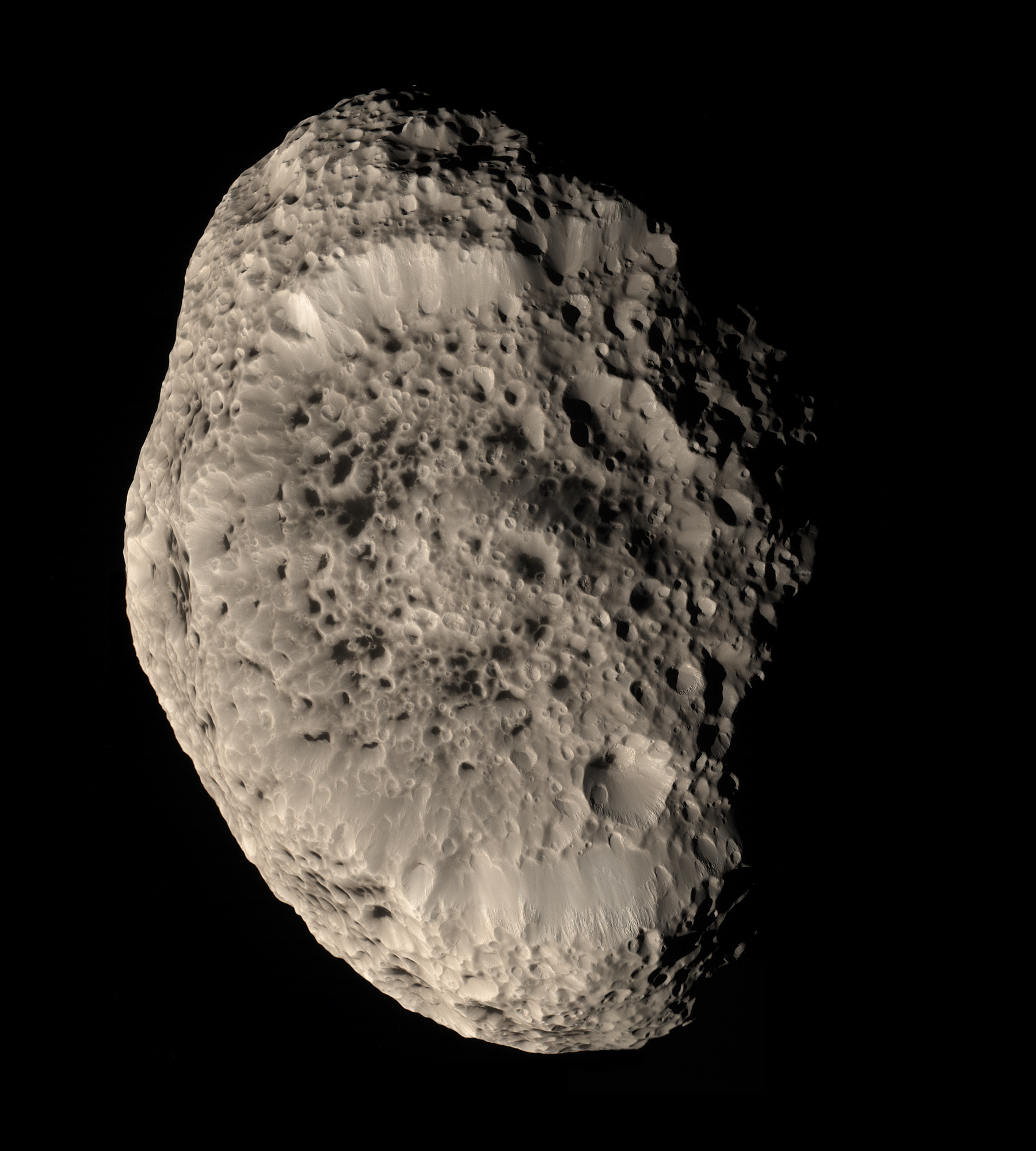
I love the delicate landslide-like features on the edges of that humongous "dimple" in Hyperion.

Image credit: NASA / JPL / SSI / Gordan Ugarkovic
What's your favourite Saturnian moon?

I love the delicate landslide-like features on the edges of that humongous "dimple" in Hyperion.

Image credit: NASA / JPL / SSI / Gordan Ugarkovic
What's your favourite Saturnian moon?
I've just "discovered" this little weird moon of Saturn, called Helene:

(true-colour composite image created by me from the raw images)
It's only approximately 30 km in diameter, but has these cool-looking dust flows on its surface. They are better visible in this saturation-enhanced version (which has some colour fringing due to the original images not lining up exactly):
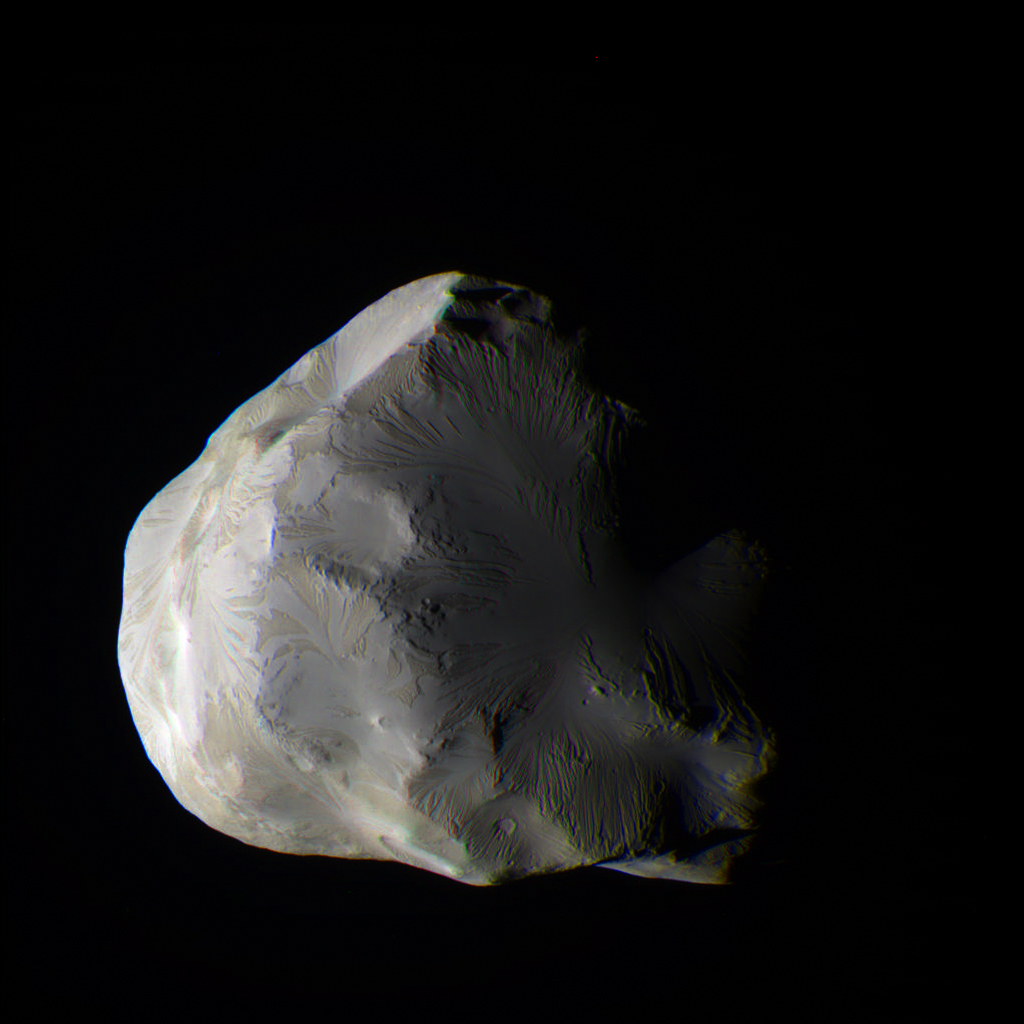
Another cool thing about Helene is that it's a "trojan moon" of another moon Dione, because it shares the same orbit as Dione at about 60 degrees ahead of its larger companion.

(true-colour composite image created by me from the raw images)
It's only approximately 30 km in diameter, but has these cool-looking dust flows on its surface. They are better visible in this saturation-enhanced version (which has some colour fringing due to the original images not lining up exactly):

Another cool thing about Helene is that it's a "trojan moon" of another moon Dione, because it shares the same orbit as Dione at about 60 degrees ahead of its larger companion.
Ah... Two questions.
One. Where are the stars? The background is just black.
Two. Why do Saturn's rings look laughably CGI?
One. Where are the stars? The background is just black.
Two. Why do Saturn's rings look laughably CGI?
a reply to: wildespace
You think that's weird, you should look at Pan and Atlas, I just learned some earthlings believe them to be UFO's!
Wha?
Pan: It was named after the ancient Greek god of the woods, who had a human head and torso and the legs, ears, and horns of a goat.
It has a mean radius of 8.8 miles (14.1 km) and orbits 83,000 miles (134,000 km) away from Saturn, within the Encke Gap of Saturn's A-ring. As it orbits Saturn every 13.8 hours.
Pan:
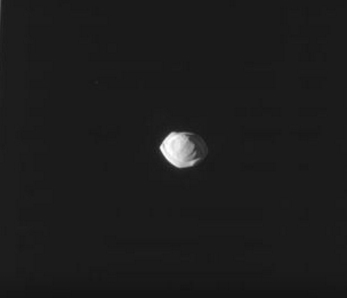
Atlas: It was named after the Titan condemned by Zeus to carry the heavens on his shoulders.
Very little is known about this moon, it has a mean radius of 9.4 miles (15.1 km). It orbits 85,544 miles (137,670 km) away, As it orbits Saturn every 14.4 hours.
Atlas:
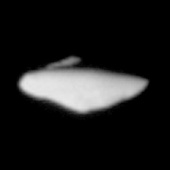
You think that's weird, you should look at Pan and Atlas, I just learned some earthlings believe them to be UFO's!
Wha?
Pan: It was named after the ancient Greek god of the woods, who had a human head and torso and the legs, ears, and horns of a goat.
It has a mean radius of 8.8 miles (14.1 km) and orbits 83,000 miles (134,000 km) away from Saturn, within the Encke Gap of Saturn's A-ring. As it orbits Saturn every 13.8 hours.
Pan:

Atlas: It was named after the Titan condemned by Zeus to carry the heavens on his shoulders.
Very little is known about this moon, it has a mean radius of 9.4 miles (15.1 km). It orbits 85,544 miles (137,670 km) away, As it orbits Saturn every 14.4 hours.
Atlas:

edit on 9-3-2017 by imitator because: (no reason given)
a reply to: imitator
Yep, that's got to be the strangest of Saturn's moons so far (I'm referring to the excellent series of threads here on ATS titled "Strange Moons")
People call it a space ravioli, but us Eastern Europeans call it a pelmen'.
Some of those raw images:
saturnraw.jpl.nasa.gov...
saturnraw.jpl.nasa.gov...
That thin equatorial ridge may be the result of Pan sweeping up the icy dust in the Encke gap (where Pan orbits)
Yep, that's got to be the strangest of Saturn's moons so far (I'm referring to the excellent series of threads here on ATS titled "Strange Moons")
People call it a space ravioli, but us Eastern Europeans call it a pelmen'.
Some of those raw images:
saturnraw.jpl.nasa.gov...
saturnraw.jpl.nasa.gov...
That thin equatorial ridge may be the result of Pan sweeping up the icy dust in the Encke gap (where Pan orbits)
originally posted by: Agent008
Ah... Two questions.
One. Where are the stars? The background is just black.
Two. Why do Saturn's rings look laughably CGI?
#1 Stars don't usually appear in spacecraft images because they're photographing a sunlit object, and sunlight is very bright. So the camera uses short exposure time. Stars are very dim and require long exposure time.
#2 They look so to you, and there's nothing anybody can help you with that. To me, they look perfectly natural (but still fascinating and really cool).
originally posted by: Agent008
Ah... Two questions.
One. Where are the stars? The background is just black.
Two. Why do Saturn's rings look laughably CGI?
One:
As Wildspace pointed out, the exposure times are very short. The exposure times for photographing a sun-lit object in space is similar to (maybe a bit longer) exposure times for taking daylight pictures here on Earth, even considering that sunlight is weaker at Saturn's distance.
So if you took a camera here on Earth with exposure settings similar to taking pictures in daylight, AND THEN took a picture of a starry sky at night using that exposure setting, you will most likely see no stars in the resulting image, even though you could see the stars in the sky with your eyes when you took the picture.
Two:
Do you have an example of what the rings should look like as seen from in orbit around Saturn?
edit on 10/3/2017 by Soylent Green Is People because: (no reason given)
Fresh off the raw Cassini archive, this image of Tethys in true colours:
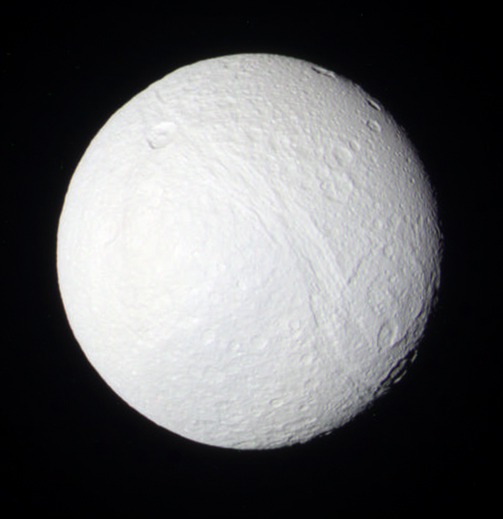
Looks very icy!

Looks very icy!
new topics
-
Shane Gillis commercial
Jokes, Puns, & Pranks: 3 hours ago -
Elon Says It’s ‘Likely’ He Buys Tanking MSNBC
Political Ideology: 6 hours ago -
Montelukast affects brain, caused 5 year old to attempt suicide
Medical Issues & Conspiracies: 7 hours ago -
Jaguar Rebrand Video Causes "WTF?" Moment - Seriously Weird
Automotive Discussion: 8 hours ago -
Let's start a conspiracy
General Conspiracies: 9 hours ago
top topics
-
Biden's "Reckless" Decision To Escalate Russia-Ukraine War
World War Three: 13 hours ago, 16 flags -
Elon Says It’s ‘Likely’ He Buys Tanking MSNBC
Political Ideology: 6 hours ago, 15 flags -
Jaguar Rebrand Video Causes "WTF?" Moment - Seriously Weird
Automotive Discussion: 8 hours ago, 14 flags -
Montelukast affects brain, caused 5 year old to attempt suicide
Medical Issues & Conspiracies: 7 hours ago, 13 flags -
What Joe Rogan said Vs The View
Dissecting Disinformation: 12 hours ago, 11 flags -
Shane Gillis commercial
Jokes, Puns, & Pranks: 3 hours ago, 4 flags -
Let's start a conspiracy
General Conspiracies: 9 hours ago, 1 flags
active topics
-
Elon Says It’s ‘Likely’ He Buys Tanking MSNBC
Political Ideology • 64 • : WeMustCare -
Well we know Putins ICBMs won't fail in their silos
World War Three • 172 • : 777Vader -
-@TH3WH17ERABB17- -Q- ---TIME TO SHOW THE WORLD--- -Part- --44--
Dissecting Disinformation • 3350 • : brewtiger123 -
President-Elect DONALD TRUMP's 2nd-Term Administration Takes Shape.
Political Ideology • 230 • : WeMustCare -
International Criminal Court Issues Arrest Warrant For Netanyahu
Mainstream News • 41 • : JJproductions -
On Nov. 5th 2024 - AMERICANS Prevented the Complete Destruction of America from Within.
2024 Elections • 158 • : WeMustCare -
Post A Funny (T&C Friendly) Pic Part IV: The LOL awakens!
General Chit Chat • 7813 • : watchitburn -
President-Elect TRUMP Picks Former Florida A.G. PAM BONDI to be U.S. Attorney General.
2024 Elections • 44 • : baddmove -
Here is why Western leaders in NATO have zero fear of nuclear warfare. At all. Zero.
World War Three • 8 • : tomeville -
The Acronym Game .. Pt.4
General Chit Chat • 979 • : JJproductions
